Planet Dinosaur – Feathered Dinosaurs
Epidexipteryx, Gigantoraptor & Microraptor
In this episode, we look at the new, bizarre and extraordinary feathered
dinosaurs, many of which have only just been discovered. Some conquered new
worlds, others grew to gigantic sizes.As we learn more about the evolution
of these feathered beasts, they’re revolutionising our understating of life
on Earth, blurring the boundaries between dinosaurs and birds.
For over a century, the great dinosaur discoveries came from North
America and Europe, but in the last decade or so the focus shifted. One
country now sits at the centre of a new dinosaur revolution – China.
In recent years, spectacular fossils have been uncovered here.
Amazingly preserved, these fossils have revealed exquisite new
details and they’re giving us incredible glimpses into an alien
world.
Possibly the strangest of all lived 154 million years ago in the late
Jurassic period. An animal that looks like nothing else on Earth.
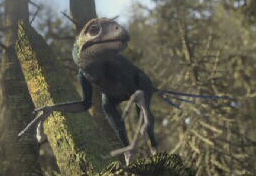
Epidexipteryx
Hiding in the forest is epidexipteryx. The size of a pigeon everything about
this creature is odd, from the length of its arms to the shape of its
teeth. The forest is home to mant predators and being small makes it
vulnerable. Being small allows it to hide and escape to the trees.
Every thing we know about epidexipteryx comes from an incredible
fossil discovered in 2008. It showed an animal with a small skull and
large eye sockets and unusually long teeth. With toes suited to gripping
branches and very long arms and hands.
It suggests this a dinosaur
well-suited to living in trees. The extraordinary elongated third finger
is another distinctive feature of the group. With this and its
projecting front teeth epidexipteryx has the perfet tools to hunt for
insects among the trees. One of its favourite foods are burrowing beetle
grubs
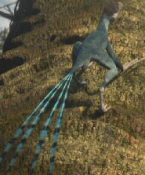
Tail Feathers
There is more to this extraordinary creature than first meets the
eye. Not only was it perfectly designed for life in the trees, but the
fossil has also reavealed it was covered in short simple feathers.
Feathers are likely to have evolved for just one reason, to keep it warm
But there is one last striking feature, four long feathers on its tail.
These feathers aren’t like those of modern birds. These are long and
ribbon-like, almost certainly only for show. They are the earliest
record of ornamental feathers, not just for attraction but also to
threaten.
In fact the very name epidexipteryx means display feather and they’re
among the most bird-like of any dinosaur. Stealing among the trees is
one thing. Stealing on the ground is quite another. Only among the trees
can they be safe from predators like sinraptor. On the ground, a few
feathers offer no protection.
The first feathered dinosaurs discovered in 1996, lots more would
follow. It suddenly appeared as if many dinosaur species actually had
feathers and confirmed what had long been suspected. A direct link
between dinosaurs and birds. A link that can be found in the dinosaurs
that lived in the Mongolian desert 85 million years ago
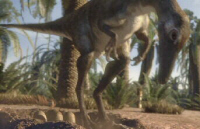
Sironithoides
This is sironithoides, a relative of the troodon family and we have
discovered fossils of these sitting on a nest. It takes days to lay a
full clutch of eggs and until that’s complete this animal won’t begin
her brooding behaviour and start sitting on the nest. With the mother
off foraging, the unguarded nest provides an open invitation to predators.
An oviraptoridae, a bizarre looking theropod dinosaur with no teeth.
They were mostly plant-eaters, but this doesn’t mean it won’t take
advantage of a different kind of lunch
We know they are plant-eaters because fossils have shown gastroliths,
stones to aid digestion, in the stomach like birds do. With two bony
projections on its upper jaw the oviraptoridae has the tools to break
into an egg. A nesting animal like sironithoides can never turn its
attention away from the nest for long. Some nest raiders are bigger than
others
Gigantoraptor was discovered in 2007 in the Gobi Desert of Mongolia.
The sheer size of the bones revealed it was unlike anything found
before, 8 metres long and weighing around 1.5 tons. From its bones we
know it was 35 times bigger than its closest raptor relative, yet the
giant wasn’t even full grown. It was like finding a mouse the size of a
cow.
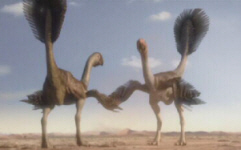
Gigantoraptor
We don’t know for sure if such a huge dinosaur like gigantoraptor
would have or need feathers. In dinosaurs, feathers are usually found as
a fine body covering and appear to be mainly for keeping warm. Feathers
were found and preserved on a fossil of one of gigantoraptors close
relatives, caudipteryx. On the forearms and tail are the unmistakable
traces of long asymmetrical feathers similar to modern birds.
It seems certain gigantoraptor too was feathered, making this the largest
feathered animal ever discovered. These aren’t for flight, gigantoraptor
couldn’t fly, nor are they for insulation. These are used to intimidate or
attract.
Across the world, discovery after discovery has revealed more and
more features from nesting to feathers that were once thought of as
exclusively bird-like, but have now also been found on dinosaurs
But, the ultimate discovery is, perhaps, that of a dinosaur that
lived in North East China around 120 million years ago. This remote area
has revealed spectacular fossils in exquisite detail. Unearthing an
astonishing diversity of animals, many of which are well adapted to
living in trees. One particular dinosaur discovery takes this to a whole
new level.
The most common dinosaur in these forests doesn’t live on the ground
– microraptor. The fossils of microraptor are so well preserved they
clearly reveal every detail of its anatomy. With distinctive claws on
its first toe this is a member of the raptor family. But, these claws
evolved for climbing rather than killing. At less than a metre long,
this was a dinosaur pefectly suited to live in the trees.
But, the fossils of microraptor reveal something else. This was a
feathered dinosaur, but these feather weren’t for keeping warm or for
show. Their structure is plainly visible from the fossils. They are very
long, veined and, most importantly, their shape creates a perfect
aerodynamic surface. They aren’t confined to its forearms, its legs too
had long feathers. These feathers are deigned for one thing only –
flight. Microraptor is a four-winged dinosaur that took to the skies.
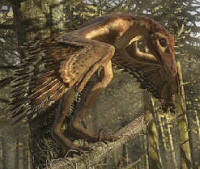
Sinornithaurus
Sinornithaurus is closely related, but larger and quite capable of
preying on microraptor. Both can fly, but this isn’t powered flight,
it’s gliding. Recent research has revealed how microraptor flew. They
didn’t have the muscles for powered flight, so instead it made the most
of its four wings. By holding it’s rear legs back and to the sides it
was able to become an incredibly efficient glider. Having longer flight
feathers on both it’s arms and legs compared to sinornithaurus,
microraptor is, by far, the better glider.
Once on the ground, the long feathers become a disadvantage.
Microraptor is barely able to walk, much less run. Sinornithaurus has no
such problem.
Sinornithaurus was one of the first feathered dinosaurs found. The
fossils are so perfectly preserved they helped us solve one of the great
dinosaur mysteries. For years, the colour of dinosaurs was thought
impossible to work out. In 2010, it was discovered the feathers on the
fossil wren’t just impressions. Under the microscope tiny structures
were revealed identical to those found in modern birds. Structures that
contained a pigment.
Remarkably, by comparing them to living birds we can even work out
the true colours. The feathers appear to be a combination of reddish
browns, yellows, greys and blacks, perfectly suited to a forest life.
Another dinosaur living in the forest is jeholosaurus, a small
plant-eating dinosaur. Recent fossils indicate this was creature that
looks after and protects its young.
With feathers that allow it to blend in with the forest,
sinornithaurus can move unseen through the treetops. Sinornithaurus is a
hunter with a secret weapon, In 2011, a study of the eyes of this creature
showed it could hunt equally well, day or night, and a study of its
teeth in 2009 showed something that definitely sets it apart from birds.
Something far more deadly. Sinornithaurus teeth have unusual and distinctive
grooves along their length. They resemble those of the venomous Gila
Monster. The team have also identified what they believe is the venom
sac.
This is a far more deadly predator than anyone imagined.




